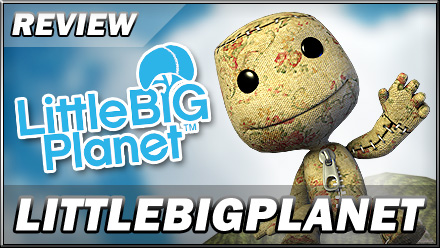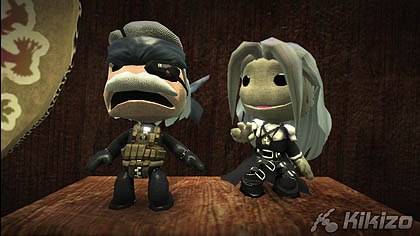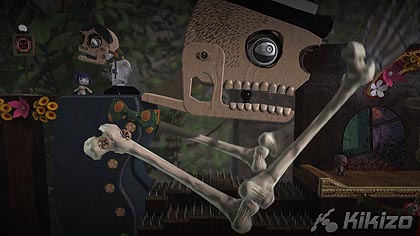LittleBigPlanet
Is the game as appealing as Sony's adorable new mascot?
| Version PlayStation 3 | Developer Media Molecule | Publisher SCE | Genre Platform |
||||

Page: 1 2
LittleBigPlanet is a masterpiece because of you. Stand up, take a bow. Pat yourself on the back.
This may not be entirely apparent at first. Chances are you won't be one of the four ex-Lionhead employees who first put pen to graph paper in 2005, or the scant two-score pros who joined them when Media Molecule was born in 2006. Chances are you won't number among the legions of Sony employees who pitched in with resources and advice over the subsequent days, months and years. And despite the publisher's Milky-Bar-Kid approach to handing out beta keys, you probably won't be one of the thousands of average joes and journos who sweated their sleeping hours away over unfinished code across September and October.
But don't worry, you're playing a part. Or rather, you will be. You're a master-artisan-in-waiting, an embryonic lord of creation. And even if you shun the ranks of this illustrious company, even if the idea of hand-crafting, testing and publishing your own platforming experience is - for reasons we'll discuss - disagreeable, you'll still be called into service as a critic, playing and commenting on the crackpot concoctions of your peers, "hearting" the very, very best to send them to the top of the online pile.
For those who've somehow managed to turn a deaf ear to Sony's relentless pimpage of this, its newfound favourite son, LittleBigPlanet is a molten hybrid of 2.5D platformer and level editor, wrought from the very latest in physics-enabled kitsch and stuffed to the seams with visionary charm. As a linear entity it provokes (and survives) comparison with the cream of Sega and Nintendo's output, from Yoshi's Island to Sonic the Hedgehog 2; as a set of game creation tools it's in a world of its own, a world thronged with braided fabric boulders and pendulous waxwork constellations, elastic bands and jetpacks. The result is a bewitching paradox: simultaneously one of the most intuitive, unpretentious and egalitarian titles we've laid eyes on, and also one of the most intricate and chimerical.
A much-voiced concern is that the second half of this equation comes at the expense of the first, but never fear - if all you want to do is hop a few platforms, bounce on a few jump pads and be home in time for tea, LittleBigPlanet has a table set aside for you. The story mode is short at around 6 to 8 hours per play-through, but as with Sonic and chums, gunning single-mindedly through the twenty-odd compulsory levels (with another thirty going spare) is only part of the fun.
The levels are grouped by continent, with the player trotting from Europe's ornamental forts through African bush, the ghoulish carnivals of Latin America and the lotus blossoms of Japan to the jagged tundra of Siberia. Each region is a vast, glorious assemblage of local materials and gadgets, stitched, hammered, bolted and glued together by the regional monarchs, themselves constructed from springs, pistons, wood and rubber.
You'll hardly need telling after month on month of screenshots and trailers, but we can't understate how appealing all this is to the eye. Media Molecule's technical and aesthetical voodoo endows the contents of toy boxes, kitchen drawers, doll's houses and sewing kits with the breed of cosy, charismatic vitality once confined to the likes of Toy Story, Old Bear and Button Moon. Hand-made buffalo trundle over scorched mahogany savannas. Fat red piñata dangle above the cardboard cacti of a pop-up book Mexico.
While the game boasts neither a Formula One frame-rate nor a gargantuan native resolution, the textures are pin-sharp and saturated with gelatinously atmospheric lighting. In acoustic terms it's a peach, too. Drawing (we suspect) on the achievements of LocoRoco, Media Molecule has sculpted a series of dynamic, polyphonic tracks which build, separate and fade as you advance through a level.
Very much the star of the show, however, is Sackboy, your irrepressible cloth puppet representative. Basic exploration is a cakewalk - left stick moves, X button jumps - but the plot thickens when you take into account the free-wheeling real-time physics and destructible objects (both composite and otherwise). R1 sees service as a grab button, letting you swing from ropes and the arms of windmills, drag sponge blocks together to form crude stairways and upset precarious balsawood pyramids. There are three movement planes, negotiable by holding up or down, and these are key to many of the secrets: alternate pathways, puzzle chambers and balloons of collectable widgets lurk behind much of the foreground scenery.
Page: 1 2













 Satoru Iwata Video Interview - the late Nintendo president spoke with Kikizo in 2004 as 'Nintendo Revolution' loomed.
Satoru Iwata Video Interview - the late Nintendo president spoke with Kikizo in 2004 as 'Nintendo Revolution' loomed. Kaz Hirai Video Interview - the first of Kikizo's interviews with the man who went on to become global head of Sony.
Kaz Hirai Video Interview - the first of Kikizo's interviews with the man who went on to become global head of Sony. Ed Fries Video Interview - one of Xbox's founders discusses an epic journey from Excel to Xbox.
Ed Fries Video Interview - one of Xbox's founders discusses an epic journey from Excel to Xbox. Yu Suzuki, the Kikizo Interview - we spend time with one of gaming's most revered creators.
Yu Suzuki, the Kikizo Interview - we spend time with one of gaming's most revered creators. Tetris - The Making of an Icon: Alexey Pajitnov and Henk Rogers reveal the fascinating story behind Tetris
Tetris - The Making of an Icon: Alexey Pajitnov and Henk Rogers reveal the fascinating story behind Tetris Rare founders, Chris and Tim Stamper - their only interview? Genuinely 'rare' sit down with founders of the legendary studio.
Rare founders, Chris and Tim Stamper - their only interview? Genuinely 'rare' sit down with founders of the legendary studio. The History of First-Person Shooters - a retrospective, from Maze War to Modern Warfare
The History of First-Person Shooters - a retrospective, from Maze War to Modern Warfare